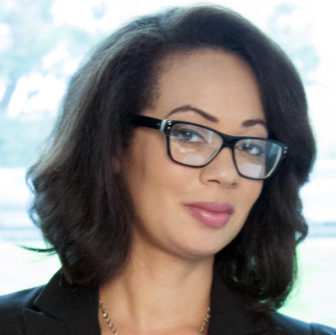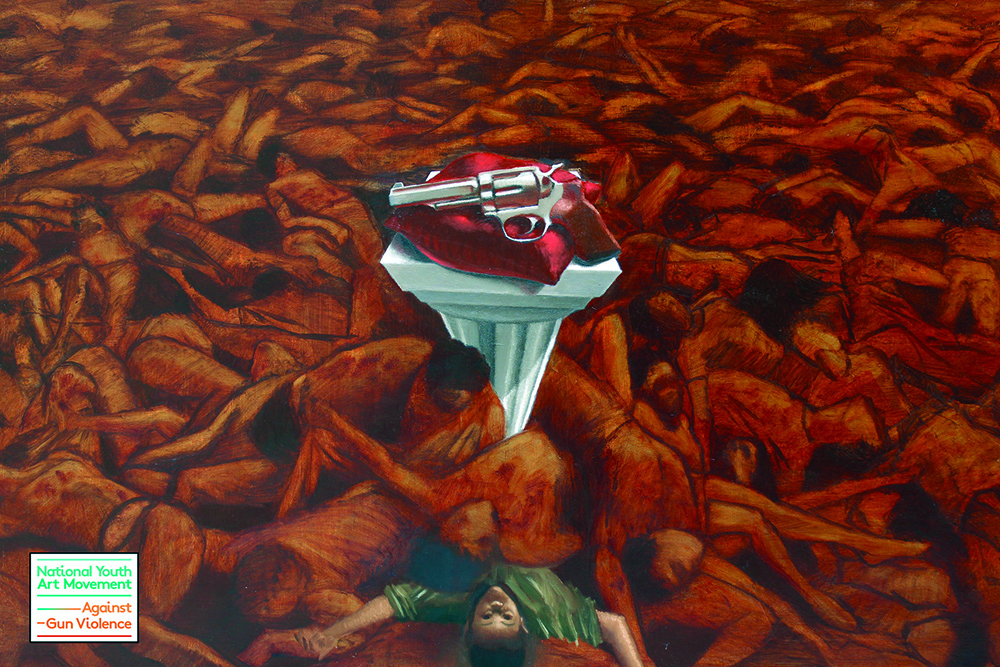![]() Art is subversive. It has a history of undermining the status quo and of transforming perceptions. The history of art as social protest goes back centuries, but modern examples that continue to play powerfully on our psyches (for those of who have seen them) are Pablo Picasso’s “Guernica,” the iconography of Black Arts Movement mantras like “Black is Beautiful,” and, more recently, Banksy’s social commentary on violence with his heavily reproduced “Flower Thrower.” These images are intended to educate, to create empathy and to compel a collective consciousness toward change.
Art is subversive. It has a history of undermining the status quo and of transforming perceptions. The history of art as social protest goes back centuries, but modern examples that continue to play powerfully on our psyches (for those of who have seen them) are Pablo Picasso’s “Guernica,” the iconography of Black Arts Movement mantras like “Black is Beautiful,” and, more recently, Banksy’s social commentary on violence with his heavily reproduced “Flower Thrower.” These images are intended to educate, to create empathy and to compel a collective consciousness toward change.

Janíce Tisha Samuels
The work of the artists of the National Youth Art Movement Against Gun Violence, a nonprofit organization dedicated to raising youth to the position of thought leaders on the issues of gun safety and gun reform, follows in the footsteps of this tradition. Due to the location of this group’s birth, it also adds new phenomena to the distinctive street art style of Chicago.
The National Youth Art Movement (NYAM) brings cohorts of youth between the ages of 13 and 27 together to discuss what the media is missing in its coverage of people and communities at risk for gun violence. Their perspective in the conversation is critical because of the impact of gun violence on their age group: The firearm homicide rate in the United States for 15- to 24-year-olds is 49 times higher in the U.S. than in any other high-income country, and 92% of all firearm deaths that occur in high-income countries among 15- to 24-year-olds happen in the U.S.
Based on these statistics, there is no doubt that young people in the U.S. are dying from gun violence in significant numbers. However, outside of school shootings, which account for less than 2% of all firearm deaths nationally, there has been very little attention given to the impact of gun violence on youth. Prior to the 2018 Parkland school shooting, very little value and space were given at a national level to youth leadership and youth voice on the issue of gun violence. It’s for these reasons that the National Youth Art Movement was founded in 2016 and why gun violence became its raison d’etre.
Art is active resistance
Understanding that youth have wisdom to share and build on, NYAM encourages its youth artists to unpack the deeply layered ways that violence or the fear of violence has affected their lives and to turn their knowledge and experience into artworks that spur engagement within the broader public for the purpose of intergenerational coalition building for gun violence prevention.
To this end, in 2017, NYAM commissioned youth in Chicago to share their stories in the form of 16 interactive artworks placed on commercial billboards across the city. Each billboard artwork was integrated with immersive augmented reality technology using an app that made the artwork come to life to provide on-the-fly teachable moments to passersby of all ages with varying perspectives and experiences with violence in the city.
This interactive public display of youth artwork on billboards is a unique and essential component of NYAM because it provides an active resistance to the marginalization of youth and the silencing of youth voice on an issue that deals with the life and death consequences of political decisions made by adults on behalf of this vulnerable population.
While NYAM was the first youth-led art activism campaign to use augmented reality on commercial billboards in Chicago and in the U.S., the use of augmented reality as a large-scale tool for social change has been growing since the Occupy Wall Street movement emerged in 2011. Mark Skwarek, a New York University professor of art and an activist against financial inequality and corporate greed, was one of thousands who planned to protest in front of the New York Stock Exchange (NYSE) on Sept. 17, 2011 but was pushed back by police to stage the protest at the nearby Zuccotti Park instead.
The imagery of protestors in front of the NYSE was critical to the Occupy movement, so undeterred, Skwarek put out an international call for photos, and an augmented reality protest filling the streets of the financial district with supporters from far and wide was fully realized. He transported in real time the bodies, the signs, the determined and concerned expressions and the voices of thousands of protestors and placed all this against the backdrop of the NYSE using augmented reality.
Holding space is critical to marginalized groups. The Occupy movement did this by physically taking over parks and college campuses throughout the country. It’s for this reason that NYAM not only virtually augments reality with an app but places large-scale artifacts of the unseen struggles of youth in areas that challenge passersby.
This placement in public space helps to connect disparate members of a community, like those who have lost loved ones to violence and those who have not, by making the invisible visible such as in the artwork “Loco Boyz,” a mixed-media painting by Chantala Kommanivanh. Chantala, NYAM’s 2017–18 lead artist, depicts a group of faceless young brown-skin men whose bodies blend and even disappear into their environment like the ubiquity of graffiti on an urban landscape; the image subtly challenging the viewer to see beyond the surface in order to acknowledge that these young men are going missing and no one is paying attention. The augmented reality for this piece superimposes tombstones where these young men once stood and asks the question: “What do we choose to ignore?”
Art activists in NYAM’s first cohort, 16- and 17-year-old Millie Martinez and Daria Velazquez, like Chantala, use their art to expose what’s missing. For Daria, what’s missing is a universal understanding that gun violence does not discriminate and that politicians who choose to oppose gun laws are holding young people hostage. Her artwork contribution to the billboard campaign was a watercolor image of a young boy, representing all races, with a pale and black-suited arm holding a gun and an American flag to his head.
For Millie, what’s missing is a real awareness of how many young people are victims to gun violence. Her billboard artwork was a painting revealing an ominous and subdued Chicago skyline punctuated with scores of sneakers tied to the wires strung between telephone poles. The augmented reality for her piece brought to life how, over time in block after block in the city, sneakers are added in memoriam for her peers, an image that begs the question of all who are witness, “For whom are we responsible?”
The National Youth Art Movement believes that as humans in co-existence we all have a responsibility to each other. That as a people living on one planet our action and our inaction have real consequences even when it seems that our lived experiences are worlds apart. It’s for this reason that whether it’s a young black man who is shot down in Chicago or a young white man committing suicide by gun in Boise, Idaho, it all matters regardless of race or circumstance. Gun violence in all its permutations is a leading cause of death for youth.
And so NYAM encourages and supports the inclusion of youth as leaders in gun violence prevention and reform and continues to provide art activism opportunities for youth empowerment. The Movement is currently in the process of extending its reach beyond out-of-school time programming and activities to include the development and deployment of an in-school arts-based curriculum and youth-led communities of practice for compassionate and creative leadership for first-year high school students. For more information visit NationalYouthArtMovement.org.
Janíce Tisha Samuels, Ed.D., is the founding executive director of the National Youth Art Movement Against Gun Violence and a graduate of Pepperdine University’s Doctor of Education in Learning Technologies program.

Pingback: Grassroots Cali “LETGO Racism” Hats Support Gun Violence Education – Cottonfreakz
Pingback: Art, Augmented Reality Are Tools for Change in Youth-led Gun Violence Movement – Juvenile Justice Information Exchange – 🔥